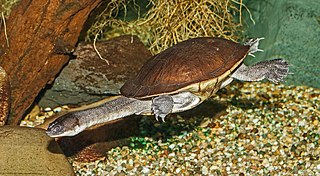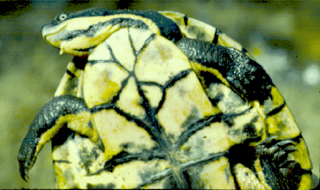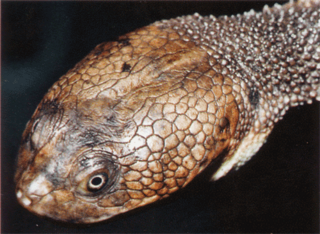
Chelidae is one of three living families of the turtle suborder Pleurodira, and are commonly called Austro-South American side-neck turtles. The family is distributed in Australia, New Guinea, parts of Indonesia, and throughout most of South America. It is a large family of turtles with a significant fossil history dating back to the Cretaceous. The family is entirely Gondwanan in origin, with no members found outside Gondwana, either in the present day or as a fossil.

Chelodina, collectively known as snake-necked turtles, is a large and diverse genus of long-necked chelid turtles with a complicated nomenclatural history. Although in the past, Macrochelodina and Macrodiremys have been considered separate genera and prior to that all the same, they are now considered subgenera of the Chelodina, further Macrochelodina and Macrodiremys are now known to apply to the same species, hence Chelydera is used for the northern snake-necked turtles.

The Roti Island snake-necked turtle, also commonly known as McCord's snakeneck turtle, is a critically endangered turtle species. It is named after Rote Island in Indonesia where it was first discovered. Some individuals were later discovered in East Timor, and are considered a distinct subspecies.

The western swamp turtle or western swamp tortoise is a critically endangered species of freshwater turtle endemic to a small portion of Western Australia. It is the only member of the genus Pseudemydura in the monotypic subfamily Pseudemydurinae.

The black spine-neck swamp turtle, also commonly known as the spiny-neck turtle or Spix's sideneck turtle, is a species of turtle in the family Chelidae. The species is endemic to South America, specially in the Southern Cone region.

The New Guinea snake-necked turtle is a species of turtle in the family Chelidae. The species is found almost exclusively within Western Province, Papua New Guinea.

Parker's snake-necked turtle is a species of turtle in the family Chelidae.
Pritchard's snake-necked turtle is a species of turtles in the family Chelidae. The species is endemic to a restricted area of Central Province, Papua New Guinea.
Reimann's snake-necked turtle is a species of turtle in the family Chelidae. The species is endemic to Oceania and Southeast Asia.

Elseya is a genus of large side-necked turtles, commonly known as Australian snapping turtles, in the family Chelidae. Species in the genus Elseya are found in river systems in northern and northeastern Australia and throughout the river systems of New Guinea. They are identified by the presence of alveolar ridges on the triturating surfaces of the mouth and the presence of a complex bridge strut.

Elseya branderhorsti, also known commonly as Branderhorst's turtle and Branderhorst's snapping turtle, is a species of freshwater turtle in the family Chelidae. The species is endemic to southern New Guinea, in West Papua Indonesia and Western Province of Papua New Guinea. Until recently it has been a confusing species due to its lost holotype and its sympatry with another, undescribed, species. E. branderhorsti is currently listed as Vulnerable on the IUCN RedList in part due to its vulnerability to the Asian turtle trade.

The Bellinger River turtle is a species of turtle in the family Chelidae. The species is of moderate size, with a straight-line carapace length to 240 mm (9.4 in) in females, and 185 mm (7.3 in) in males. It is endemic to Australia with a highly restricted distribution to the small coastal drainage of the Bellinger River in New South Wales. In the past the species was considered locally abundant. The species' preferred habitat is the deeper pools of the clear-water upstream reaches of the river, where water flows continuously in most months over a bedrock basement and a stream bed of boulders, pebbles, and gravel. A captive breeding program has been under way since a 2015 virus outbreak came close to wiping out the entire species. Most remaining individuals are currently housed in quarantine, though a small number have been reintroduced to the original habitat.

The Western New Guinea stream turtle or New Guinea snapping turtle is a species of freshwater turtle in the Chelidae family. It is found in the Bird's Head Peninsula and the Bomberai Peninsula west of Cenderawasih Bay, and on the island of Waigeo of West Papua, Indonesia.

Emydura, the Australian short-necked turtles, are a genus of turtles in the family Chelidae. It was paraphyletic with Elseya. Consequently, it was split into two genera Myuchelys and Elseya by Thomson & Georges, 2009. They can grow quite large, 30 cm or more is not unusual and have a life span of around 20–30 years. They generally do not hibernate as their warmer climate lets them remain active all year round; they also spend more time in the water than other varieties. They are considered omnivore but rely on a constant supply of meat to remain healthy, feeding on basically anything that will fit into their mouth.

The Myuchelys is a genus of turtles, the Australian saw-shelled turtles, in the family Chelidae and subfamily Chelodininae. They inhabit the headwaters and tributaries of rivers within their range and this led to the name Myuchelys, which is formed from the Aboriginal word myuna meaning clear water and the Greek chelys meaning turtle. They have a short neck and the intergular scute completely separates the gular scutes. They have no alveolar ridge separating them from the snapping turtles of the genus Elseya.

Chelodina canni, also known commonly as Cann's snake-necked turtle, is a species of turtle in the family Chelidae. The species is endemic to Australia, where it is found in the northern and northeastern parts of the continent. It has a narrow zone of hybridization with its related species the eastern snake-necked turtle, C. longicollis. For many years C. canni was assumed to be the same species as C. novaeguineae from New Guinea. However, in 2002 it was shown that these two species differ both morphologically and genetically, and therefore C. canni was separated and described as a unique species.

Chelodina (Chelydera) burrungandjii, the sandstone snake-necked turtle or Arnhem Land long-necked turtle, is a medium-sized turtle reaching carapace lengths of 316 mm. The species is found in the sandstone plateaus and escarpments and the plunge pools of Arnhem Land of the Northern Territory. The species had been long recognised as valid. However, it had been difficult to research due to the remoteness of its habitat. Efforts to breed this species in captivity had been largely unsuccessful, until National Aquarium Herpetologist Matthew Benedict lead a successful breeding project in 2021. The species occurs in proximity to Chelodina rugosa, to which it is closely related. For the most part the two species are parapatric in distribution. However, they do come together in limited locations such as plunge pools at the base of the escarpments. In these areas there is hybridization between the species.

Emydura victoriae, also known commonly as the red-faced turtle, Victoria short-necked turtle and Victoria River turtle, is a species of medium-sized aquatic turtle in the family Chelidae. The species inhabits rivers, streams and permanent water bodies across much of northern Australia.

Elseya schultzei, commonly known as Schultze's snapping turtle, is a species of chelid turtle endemic to northern New Guinea.

The "Standard Event System" (SES) to Study Vertebrate Embryos was developed in 2009 to establish a common language in comparative embryology. Homologous developmental characters are defined therein and should be recognisable in all vertebrate embryos. The SES includes a protocol on how to describe and depict vertebrate embryonic characters. The SES was initially developed for external developmental characters of organogenesis, particularly for turtle embryos. However, it is expandable both taxonomically and in regard to anatomical or molecular characters. This article should act as an overview on the species staged with SES and document the expansions of this system. New entries need to be validated based on the citation of scientific publications. The guideline on how to establish new SES-characters and to describe species can be found in the original paper of Werneburg (2009).




















